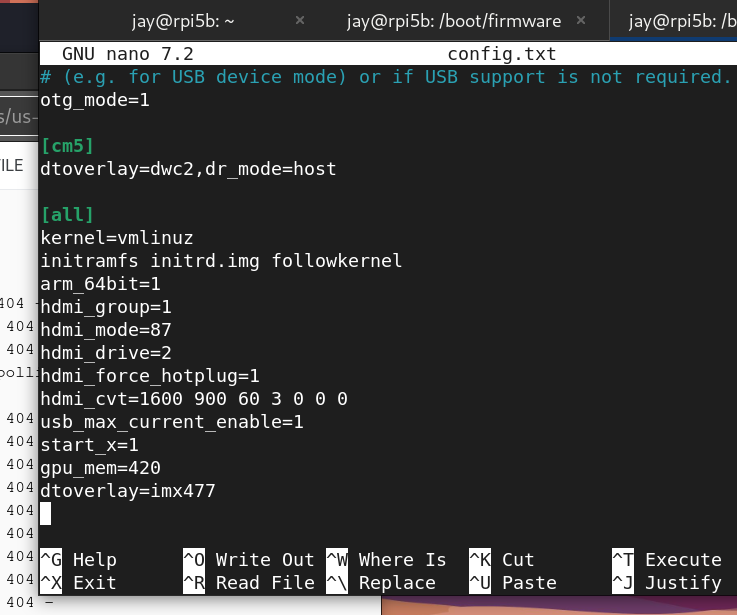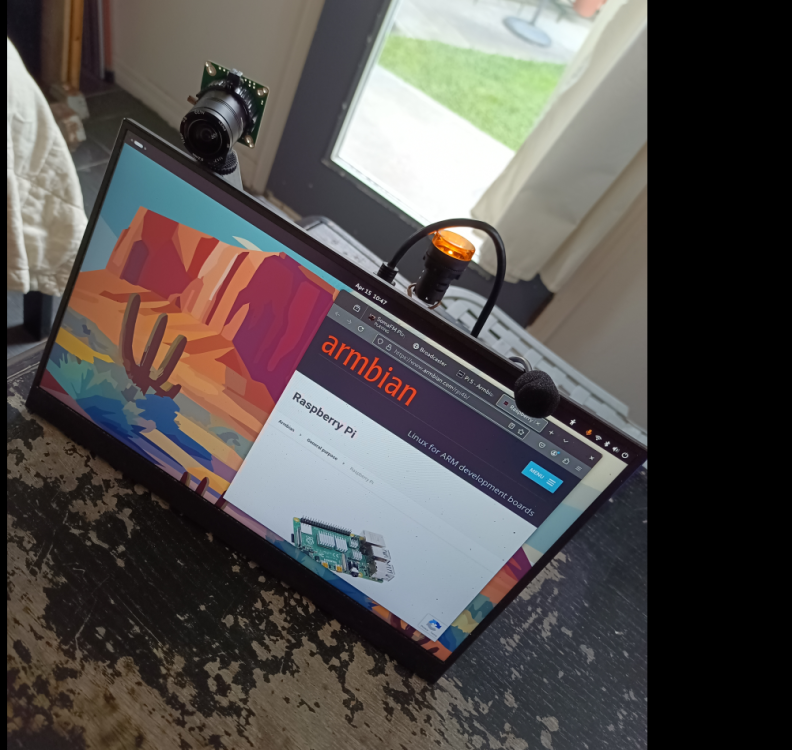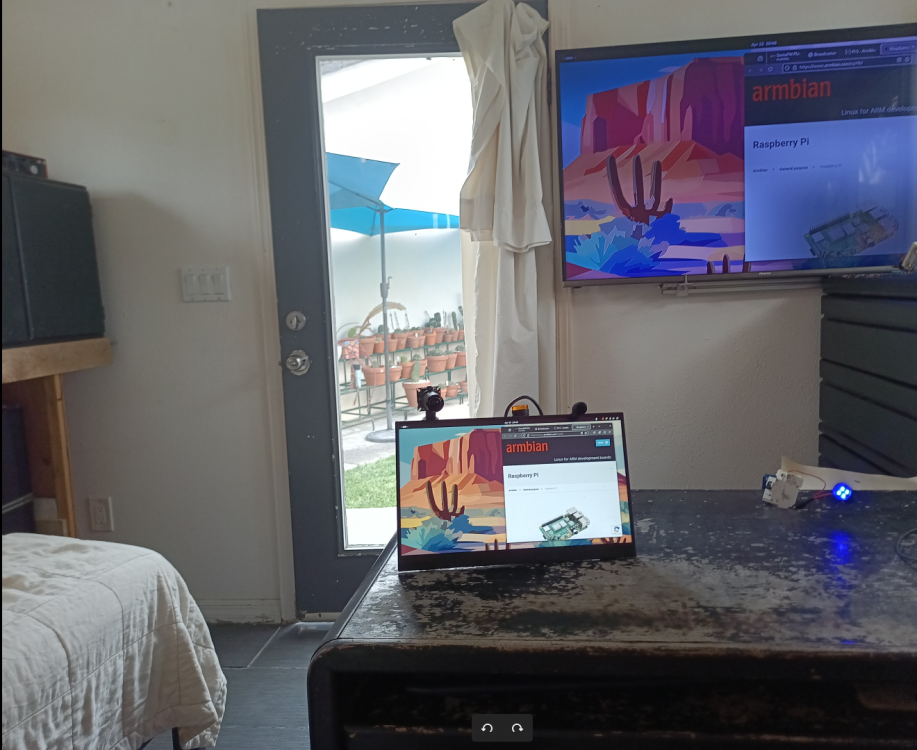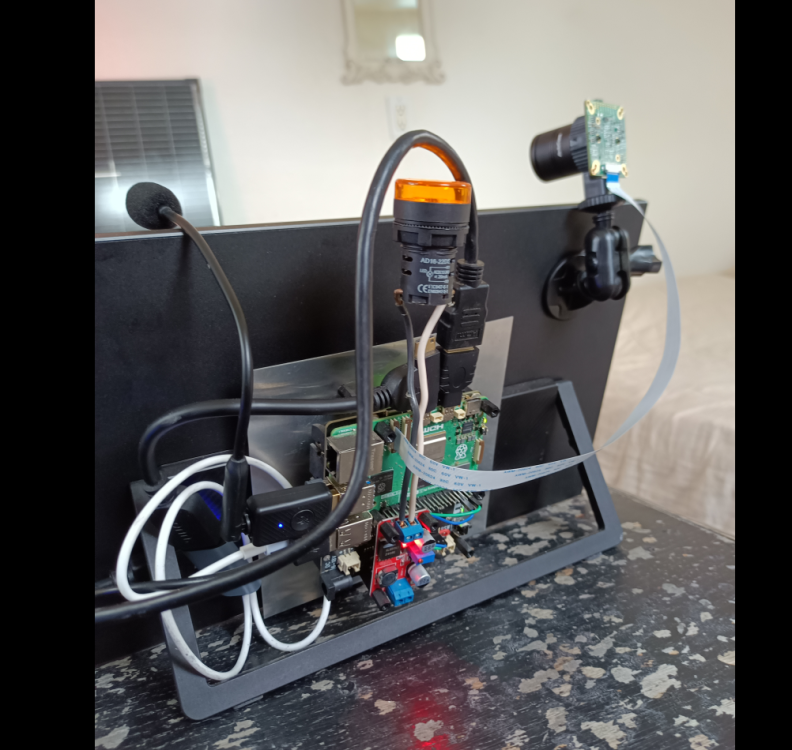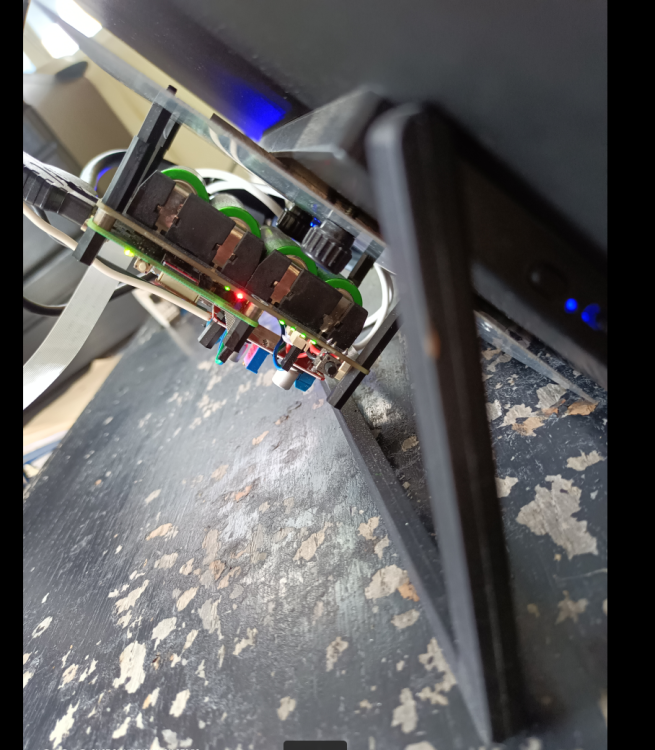Active threads
Showing topics posted in for the last 365 days.
- Past hour
-
@Angel Luis Pérezthank you for you help, you can test i2c attaching a sensor like MPU6050 in the i2c pins (TWI4, TWI1, TW5), enable the i2c like in the orange pi user manual (add the overlay in /boot/extlinux/extlinux.com), and use the same command to test the i2c (sudo i2cdetect -y 4), it will show a table with all the i2c devices attached with their addresses, for instance if you are using a MPU6050 it will report the address 0x68, mine it is not reporting the address, it pauses the scanning for five seconds at the column 60 and the row 8, meaning that it is like detecting the address but finally it doesn't reports nothing, so it results with an empty table, also i tried to write and read registers but without success. also i tried to connect an arduino acting as i2c slave device and printing every device information, including when it acknowledges the address, for debugging purposes, the arduino acknowledges the programmed address (0x20), but the orange pi 4a can't see any attached device, also the arduino can't receive any data.
-

Does Armbian (Debian) support GPU acceleration on the XU4?
igagis replied to freezr's topic in Odroid XU4
Unfortunately, I'm not the one dedicated enthusiast with plenty of time, my time is very limited. So, I'd wait for such an enthusiast to appear too :). I'd even donate one of my Odroid XU4 boards to that potential enthusiast, who would add GPU support to Armbian. - Today
-

libssl1.1 Not possible to install
Kaeter replied to Dombo 71's topic in Software, Applications, Userspace
Small change on the .deb link in case it is missing. I was using this link for the wget: https://security.debian.org/debian-security/pool/updates/main/o/openssl/libssl-dev_1.1.1n-0+deb10u6_arm64.deb And it does make my domoticz install script works. Thanks to Sergey for the guide🙏. -
Yes, please post it here. There may be several suggestions (explanations) as a short instruction for use.
-

FriendlyElec CM3588Plus NAS - nvme's overheating (75C)
Werner replied to serverlesslove's topic in Rockchip
Hi Providing logs with PASTE_SERVER_HOST=paste.armbian.de armbianmonitor -u helps with troubleshooting and significantly raises chances that issue gets addressed. -

Armbian doesnt seem to see sata harddrives.
Popolon replied to DontMindMe's topic in Radxa Rock 5 ITX
I both cases I copied the dmesg file: * 6.1_noSATA.txt (both hdmi, no sata) (400/401, no more SATA), was the best 2 days ago (~390 good GL accelaration, sata+2 HDMI out + HDMI in) * 6.12_noHDMI.txt (no hdmi, sata) * 6.15_noHDMI.txt (hdmi only left port, sata) 6.15 booting, when wire was connected on right port: [ 2.383100] rockchip-drm display-subsystem: bound fdd90000.vop (ops rockchip_drm_fini [rockchipdrm]) [ 2.397151] dwhdmiqp-rockchip fdea0000.hdmi: registered DesignWare HDMI QP I2C bus driver [ 2.397431] rockchip-drm display-subsystem: bound fdea0000.hdmi (ops rockchip_drm_fini [rockchipdrm]) [ 2.403676] usb 1-1.4: new low-speed USB device number 3 using ehci-platform [ 2.411243] [drm] Initialized rockchip 1.0.0 for display-subsystem on minor 1 [ 2.411291] rockchip-drm display-subsystem: [drm] Cannot find any crtc or sizes [ 2.411330] rockchip-drm display-subsystem: [drm] Cannot find any crtc or sizes grep -i hdmi 6.12_noHDMI.txt => nothing grep -i hdmi 6.1_noSATA.txt [ 8.759715] platform fdd90000.vop: Fixed dependency cycle(s) with /hdmi@fdea0000 [ 8.759747] platform fdea0000.hdmi: Fixed dependency cycle(s) with /vop@fdd90000 [ 9.889229] phy phy-fed60000.hdmiphy.9: Looking up phy-supply from device tree [ 9.889236] phy phy-fed60000.hdmiphy.9: Looking up phy-supply property in node /hdmiphy@fed60000 failed [ 9.890012] rockchip-hdptx-phy-hdmi fed60000.hdmiphy: hdptx phy init success [ 9.890208] phy phy-fed70000.hdmiphy.10: Looking up phy-supply from device tree [ 9.890215] phy phy-fed70000.hdmiphy.10: Looking up phy-supply property in node /hdmiphy@fed70000 failed [ 9.890965] rockchip-hdptx-phy-hdmi fed70000.hdmiphy: hdptx phy init success [ 9.954935] dwhdmi-rockchip fdea0000.hdmi: Looking up avdd-0v9-supply from device tree [ 9.954945] dwhdmi-rockchip fdea0000.hdmi: Looking up avdd-0v9-supply property in node /hdmi@fdea0000 failed [ 9.954957] dwhdmi-rockchip fdea0000.hdmi: Looking up avdd-1v8-supply from device tree [ 9.954965] dwhdmi-rockchip fdea0000.hdmi: Looking up avdd-1v8-supply property in node /hdmi@fdea0000 failed [ 9.955465] dwhdmi-rockchip fdea0000.hdmi: registered ddc I2C bus driver [ 9.956114] rockchip-drm display-subsystem: bound fdea0000.hdmi (ops 0xffff8000093b2958) [ 10.324345] dw-hdmi-qp-hdcp dw-hdmi-qp-hdcp.2.auto: dw_hdcp_qp_hdcp_probe success [ 10.325032] rc rc0: dw_hdmi_qp as /devices/platform/fdea0000.hdmi/rc/rc0 [ 10.325144] input: dw_hdmi_qp as /devices/platform/fdea0000.hdmi/rc/rc0/input0 [ 10.419959] rk_hdmirx fdee0000.hdmirx-controller: No reserved memory for HDMIRX, use default CMA [ 10.419979] rk_hdmirx fdee0000.hdmirx-controller: hdmirx_get_phy_cpuid_func: mpidr: 0x0000000500, phy_cpuid:0x5 [ 10.419994] rk_hdmirx fdee0000.hdmirx-controller: hdmirx_probe: cpu_aff:0x500, Bound_cpu:5, wdt_cfg_bound_cpu:2, phy_cpuid:5 [ 10.421528] rk_hdmirx fdee0000.hdmirx-controller: rk_hdmirx_hdcp_register success [ 10.421554] rk_hdmirx fdee0000.hdmirx-controller: fdee0000.hdmirx-controller driver probe ok! [ 10.499993] input: rockchip-hdmi1 rockchip-hdmi1 as /devices/platform/hdmi1-sound/sound/card0/input1 [ 10.500682] input: rockchip-hdmi0 rockchip-hdmi0 as /devices/platform/dp0-sound/sound/card1/input2 [ 10.501573] input: rockchip-hdmi2 rockchip-hdmi2 as /devices/platform/dp1-sound/sound/card2/input3 [ 10.514194] input: rockchip-hdmiin rockchip-hdmiin as /devices/platform/hdmiin-sound/sound/card3/input4 [ 10.674959] rockchip-dmc dmc: hdmirx_rate = 2400000000 [ 10.765472] #0: rockchip-hdmi1 [ 10.765482] #1: rockchip-hdmi0 [ 10.765490] #2: rockchip-hdmi2 [ 10.765498] #3: rockchip-hdmiin [ 12.561199] rk_hdmirx fdee0000.hdmirx-controller: hdmirx_cancel_cpu_limit_freq freq qos nod add grep -i sata 6.1 => nothing grep -i sata 6.12/6.15, give the same lines: [ 4.181816] ahci 0001:11:00.0: AHCI vers 0001.0301, 32 command slots, 6 Gbps, SATA mode [ 4.206376] ata1: SATA max UDMA/133 abar m8192@0xf1282000 port 0xf1282100 irq 160 lpm-pol 0 [ 4.206388] ata2: SATA max UDMA/133 abar m8192@0xf1282000 port 0xf1282180 irq 160 lpm-pol 0 [ 4.206398] ata3: SATA max UDMA/133 abar m8192@0xf1282000 port 0xf1282200 irq 160 lpm-pol 0 [ 4.206407] ata4: SATA max UDMA/133 abar m8192@0xf1282000 port 0xf1282280 irq 160 lpm-pol 0 [ 4.206437] ata9: SATA max UDMA/133 abar m8192@0xf1282000 port 0xf1282500 irq 160 lpm-pol 0 [ 4.206445] ata10: SATA max UDMA/133 abar m8192@0xf1282000 port 0xf1282580 irq 160 lpm-pol 0 [ 4.206453] ata11: SATA max UDMA/133 abar m8192@0xf1282000 port 0xf1282600 irq 160 lpm-pol 0 [ 4.206462] ata12: SATA max UDMA/133 abar m8192@0xf1282000 port 0xf1282680 irq 160 lpm-pol 0 [ 4.206470] ata13: SATA max UDMA/133 abar m8192@0xf1282000 port 0xf1282700 irq 160 lpm-pol 0 [ 4.206479] ata14: SATA max UDMA/133 abar m8192@0xf1282000 port 0xf1282780 irq 160 lpm-pol 0 [ 4.206487] ata15: SATA max UDMA/133 abar m8192@0xf1282000 port 0xf1282800 irq 160 lpm-pol 0 [ 4.206495] ata16: SATA max UDMA/133 abar m8192@0xf1282000 port 0xf1282880 irq 160 lpm-pol 0 [ 4.206504] ata17: SATA max UDMA/133 abar m8192@0xf1282000 port 0xf1282900 irq 160 lpm-pol 0 [ 4.206512] ata18: SATA max UDMA/133 abar m8192@0xf1282000 port 0xf1282980 irq 160 lpm-pol 0 [ 4.206520] ata19: SATA max UDMA/133 abar m8192@0xf1282000 port 0xf1282a00 irq 160 lpm-pol 0 [ 4.206528] ata20: SATA max UDMA/133 abar m8192@0xf1282000 port 0xf1282a80 irq 160 lpm-pol 0 [ 4.206537] ata21: SATA max UDMA/133 abar m8192@0xf1282000 port 0xf1282b00 irq 160 lpm-pol 0 [ 4.206545] ata22: SATA max UDMA/133 abar m8192@0xf1282000 port 0xf1282b80 irq 160 lpm-pol 0 [ 4.206553] ata23: SATA max UDMA/133 abar m8192@0xf1282000 port 0xf1282c00 irq 160 lpm-pol 0 [ 4.206561] ata24: SATA max UDMA/133 abar m8192@0xf1282000 port 0xf1282c80 irq 160 lpm-pol 0 [ 10.059389] ata1: SATA link up 6.0 Gbps (SStatus 133 SControl 300) [ 10.374890] ata2: SATA link down (SStatus 0 SControl 300) [ 10.686794] ata3: SATA link up 6.0 Gbps (SStatus 133 SControl 300) [ 11.002741] ata4: SATA link up 6.0 Gbps (SStatus 133 SControl 300) [ 11.319039] ata9: SATA link down (SStatus 0 SControl 300) [ 11.631097] ata10: SATA link down (SStatus 0 SControl 300) [ 11.943048] ata11: SATA link down (SStatus 0 SControl 300) [ 12.255094] ata12: SATA link down (SStatus 0 SControl 300) [ 12.567104] ata13: SATA link down (SStatus 0 SControl 300) [ 12.878769] ata14: SATA link down (SStatus 0 SControl 300) [ 13.190881] ata15: SATA link down (SStatus 0 SControl 300) [ 13.502881] ata16: SATA link down (SStatus 0 SControl 300) [ 13.814880] ata17: SATA link down (SStatus 0 SControl 300) [ 14.126879] ata18: SATA link down (SStatus 0 SControl 300) [ 14.438881] ata19: SATA link down (SStatus 0 SControl 300) [ 14.750834] ata20: SATA link down (SStatus 0 SControl 300) [ 15.062884] ata21: SATA link down (SStatus 0 SControl 300) [ 15.375003] ata22: SATA link down (SStatus 0 SControl 300) [ 15.687007] ata23: SATA link down (SStatus 0 SControl 300) [ 15.999009] ata24: SATA link down (SStatus 0 SControl 300) 6.1_noSATA.txt 6.12_noHDMI.txt 6.15_noHDMI.txt -
okay, thanks 🙂
-
......... You are correct. Well, that explains that. The Kickpi I have has 8GB EMMC and I was wondering why I didn't see any reports of people installing to it.
-
hi, I tested also xfce on the system, have some notes to installation (also others available uefi-x86 images) and will continue here as armbian newbie describing experiences. for now, quick notes: grub config - tiny: would be nice to have here some most used items explicitly defined as help/doc too - mainly delay(?) ... as a newbie, will be easy to modify existing item than search for it boot - selecting locale - when I was finding CZ, it is in some images listed as 98, somewhere as 99 ... probably the list is not consistent (I dont know if it was goal, but having this list stable can be handy) - tiny quirk - some images miss board logo, debian images even miss armbian logo and there is debian 12 default, okay )) armbian-config - storage - install should have probably alphabetically sorted items, as in some case nvme1 is listed first and selected by default, better nvme0, of course 🙂 - also, it seems that in some images, desktop icon for this launches using sudo and elsewhere without it, some images failed storage-install from icon, by sudo from terminal, okay (I also realized that uefi-x86 has obviously drastically simple armbian-config vs arm sbc boards, sure ... had chatgpt involved in discussion what all to possible configure on armbian installed systems - if its possible to trust all what it replied, will see ... I am totally new to GPU related things like mesa, panfrost, wayland etc etc ... gpt is good source of comparison info, imho, I ued it as teacher available 24/7, expecting also invented halucinations, sure )) Xfce - gparted was unable to launch from menu?? dont know why yet I am making these notes here for myself also, can try to peek inside armbian-config sources soon to learn how things are done and try to solve it, if possible (few years ago I did my very first bash work related to John Winans Z80retro! as CP/M firmware change/backup toolkit for midnight commander, so far so good experience, bash is okay) cheers Petr
-
here is the complete brcm wifi BT firmware I found it may have firware useful for other wifi BT devices. brcm.zip
- Yesterday
-

Very simple module for nothing, Segmentation fault
Mariano1977 replied to Kopia's topic in Allwinner sunxi
Great analysis @mue473! Thanks a lot! -
[deleted]
-
This May, Embedded Recipes 2025, co-sponsored by Collabora, heads to Nice, France with talks, workshops, and a PipeWire hackfest, all bookended by the Linux Media Summit and the GStreamer Spring Hackfest! View the full article
-
Hello all, I have returned to my topic with a righteous update!!! I started with Armbian Server Noble. This is my PI5.....It needs camera support and libinput/weston for touch. However, I have run this .sh script #!/bin/bash sudo apt update -y && sudo apt upgrade && sudo apt install lightdm && sudo apt upgrade && sudo apt update -y && sudo apt install linux-headers-current-bcm2711 linux-headers-edge-bcm2712 && sudo apt update -y && sudo apt upgrade && sudo apt install gnome* ffmpeg qgnomeplatform-qt5 qt5-image-formats-plugins qt5-qmltooling-plugins qtvirtualkeyboard-plugin qttranslations5-l10n libqt5svg5 qt5-gtk-platformtheme qtwayland5 alsa* pavucontrol vulkan-tools mesa-vulkan-drivers xdg-desktop-portal-gnome libspa-0.2-bluetooth qv4l2 v4l2loopback-dkms obs-plugins obs-studio gnome-tweaks rpi-imager to produce my media script aswell as edit config.txt after flashing. Touch and Camera next friends....
-
Any tip to getting HDMI audio to work on version 5.1 of the board?
-
Thank you Werner. I'm not into Armbian enough to understand how the hardware is supported across all the kernel versions. The best I can do is to test different versions until I find the mininum support for the things I want to do. Till now, kernel 6.1.99-vendor-rk35xx works more or less, but SATA HDDs are not always detected at boot. OS is installed on a NMVE pcie drive, while the main storage is given by 2 4TB drives in RAID1. HDMI output doesn't work for me when kernel 6.12 is used (I have rock 5 ITX - Board version 1.12). Kernel 15-rc solves the SATA support, but audio doesn't work. I went throught many webpages to check if I can solve some issues here and there, but my limited knowledge doesn't allow me to really understand what's going on and the interactions between elements of the system. I have to rely on the hard work of the developers community, waiting for better support in the future, if any.
-
tl;dr; It a business support / donation deal between Armbian and SBC maker. We have some budget, we aim on at least positive zero, and we have some people behind those boards. This doesn't mean we will be able to resolve all problems and in real-time as budget is still too small and resources remain limited. Support is better https://docs.armbian.com/User-Guide_Board-Support-Rules/ then on boards without.
-
Any updates on this? I am just trying to install Armbian on the eMMC of 5B. It’s not working, so I ran into this thread. If possible, I wouldn’t want to open the case (and undo the thermal tape) to access the maskrom button, so I was wondering if the you think the instructions of sns1801 could be adapted to constructing a new image with several invocations of dd? Then use any image on an SD to flash the custom image from a USB stick using dd?
- Last week
-
Hi Everybody, I'm trying to set up Nextcloud with Collabora Office on NanoPi R4S running Armbian, but I'm having trouble configuring the reverse proxy (nginx/Caddy) for HTTPS with local domains. Current Setup: Running via docker-compose.yml (shown below) Without HTTPS, everything works: Collabora can open documents in Nextcloud's web UI With HTTPS enabled, Collabora integration breaks Added to /etc/hosts: 127.0.0.1 nextcloud.lan collabora.nextcloud.lan What I Need: HTTPS configuration for both services Reverse proxy to local domains: Nextcloud: https://nextcloud.lan Collabora: https://collabora.nextcloud.lan My docker-compose.yml (HTTP-only version): networks: network: driver: bridge volumes: mariadb_config: mariadb_data: nextcloud_config: nextcloud_data: services: collabora: image: collabora/code restart: unless-stopped container_name: collabora hostname: collabora domainname: collabora.nextcloud.lan networks: - network ports: - "9980:9980" cap_add: - MKNOD nextcloud_db: image: linuxserver/mariadb restart: unless-stopped container_name: nextcloud_db hostname: nextcloud_db networks: - network volumes: - mariadb_config:/config - mariadb_data:/data environment: - PUID=1000 - PGID=1000 - TZ=UTC - MYSQL_ROOT_PASSWORD=nextcloud - MYSQL_DATABASE=nextcloud_db - MYSQL_USER=nextcloud - MYSQL_PASSWORD=nextcloud nextcloud: image: linuxserver/nextcloud restart: unless-stopped depends_on: - nextcloud_db - collabora container_name: nextcloud hostname: nextcloud domainname: nextcloud.lan networks: - network ports: - "8080:80" volumes: - nextcloud_config:/config - nextcloud_data:/data environment: - PUID=1000 - PGID=1000 - TZ=UTC - NEXTCLOUD_UPLOAD_LIMIT=16G - NEXTCLOUD_MAX_TIME=3600 - NEXTCLOUD_MEMORY_LIMIT=3G - SKIP_DOMAIN_VALIDATION=true - NEXTCLOUD_TRUSTED_DOMAINS=nextcloud.lan Key Questions: How should I modify the docker-compose.yml to: Enable HTTPS for both services? Properly configure the reverse proxy for the local domains? Set up valid SSL certificates for *.lan domains? For Collabora: What extra_params or environment variables are needed for HTTPS? How to configure Nextcloud's config.php for the Collabora HTTPS endpoint? I'd prefer a solution using Caddy if possible, as it's simpler for automatic HTTPS. Any working configuration examples would be greatly appreciated! Thanks in advance for your help! Viktor Malygin WordPress Developer
-
i have a image working with some h616; you may try; i will give the link here
-
PanVK has reached a new milestone, and is now officially conformant with the Vulkan 1.1 specification on the Arm Mali-G610 GPU! The submission was done from the Mesa 25.0.2 release, and covers both armhf as well as aarch64 architectures. View the full article
-

How to set correctly GPIO flags in dts files?
firepower replied to TRay's topic in Advanced users - Development
/* Bit 0 express polarity */ #define GPIO_ACTIVE_HIGH 0 #define GPIO_ACTIVE_LOW 1 /* Bit 1 express single-endedness */ #define GPIO_PUSH_PULL 0 #define GPIO_SINGLE_ENDED 2 /* Bit 2 express Open drain or open source */ #define GPIO_LINE_OPEN_SOURCE 0 #define GPIO_LINE_OPEN_DRAIN 4 /* * Open Drain/Collector is the combination of single-ended open drain interface. * Open Source/Emitter is the combination of single-ended open source interface. */ #define GPIO_OPEN_DRAIN (GPIO_SINGLE_ENDED | GPIO_LINE_OPEN_DRAIN) #define GPIO_OPEN_SOURCE (GPIO_SINGLE_ENDED | GPIO_LINE_OPEN_SOURCE) /* Bit 3 express GPIO suspend/resume and reset persistence */ #define GPIO_PERSISTENT 0 #define GPIO_TRANSITORY 8 when combining add the bits #define GPIO_OPEN_DRAIN (GPIO_SINGLE_ENDED | GPIO_LINE_OPEN_DRAIN) is 2+4= 6 gpios = <&pio 0 7 (GPIO_ACTIVE_HIGH|GPIO_OPEN_DRAIN)>; or gpios = <&pio 0 7 4>; -
Introducing Armbian’s New Cloud Images: Optimized for x86 and aarch64 Cloud Deployments Armbian is taking a significant step forward in cloud computing support with the introduction of dedicated cloud images tailored for cloud environments. The latest enhancement brings a new ‘cloud’ image set specifically designed to optimize generic x86 and aarch64 deployments, ensuring better performance, security, and compatibility in cloud infrastructures. Why Dedicated Cloud Images? As more enterprises and developers deploy lightweight Linux images in cloud environments, the need for a streamlined, cloud-optimized configuration has grown. The new ‘cloud’ images aim to address this by focusing on: Very Fast Boot Time: Optimized configurations enable boot times as fast as 1-2 seconds, ensuring rapid deployment and responsiveness. No Firmware Package: By eliminating unnecessary firmware packages, the cloud images remain lightweight and focused on essential cloud functionality. Optimized Performance: Stripped of unnecessary hardware drivers, the cloud images are leaner, allowing faster boot times and improved efficiency. Enhanced Compatibility: Fine-tuned configurations ensure that Armbian-based cloud instances run seamlessly across major cloud providers, including AWS and Azure. Security-Focused Design: With a minimal attack surface, the cloud images reduce exposure to vulnerabilities while maintaining essential features. Lightweight Image Size: The uncompressed QCOW2 image is approximately 700MB, ensuring minimal resource usage while maintaining full functionality. Docker Support Enabled by Default: The cloud images come preconfigured with Docker support out of the box, allowing seamless deployment of containerized applications. Lean Debian Bookworm or Ubuntu Noble User Space: Provided images come with a minimal yet powerful user space based on Debian Bookworm or Ubuntu Noble, ensuring stability and efficiency. ZRAM Management: Built-in ZRAM management optimizes memory usage, improving performance in resource-constrained environments. Armbian-Config System Configuration Utility: The powerful armbian-config tool provides an easy way to configure and manage system settings, enhancing user experience and customization. Customize and Brand Your Cloud Image Armbian makes it incredibly simple to create custom, cloud-optimized images tailored to your needs. Whether you’re an enterprise or an individual developer, you can brand and configure your Armbian cloud images to match your identity and requirements. Have always fresh Armbian OS with your brand! By leveraging the Armbian build framework, you can easily build your own cloud images with custom configurations, packages, and branding. Get started today by visiting the official Armbian build repository. Build command example: ./compile.sh \ BETA=no \ BOARD=uefi-x86 \ BRANCH=cloud \ BUILD_DESKTOP=no \ BUILD_MINIMAL=yes \ ENABLE_EXTENSIONS=image-output-qcow2 \ IMAGE_VERSION=25.2.3 \ RELEASE=noble \ VENDOR="Company" \ VENDORCOLOR="5;100;115" \ KERNEL_CONFIGURE=no \ KERNEL_BTF=yes Download links You can find download links at https://www.armbian.com/download/, or use the direct links below. For the QEMU disk image (QCOW2) format: https://dl.armbian.com/uefi-x86/Bookworm_cloud_minimal-qcow2 https://dl.armbian.com/uefi-x86/Noble_cloud_minimal-qcow2 https://dl.armbian.com/uefi-arm64/Bookworm_cloud_minimal-qcow2 https://dl.armbian.com/uefi-arm64/Noble_cloud_minimal-qcow2 and Microsoft Azure image format: https://dl.armbian.com/uefi-x86/Bookworm_cloud_minimal-hyperv https://dl.armbian.com/uefi-x86/Noble_cloud_minimal-hyperv https://dl.armbian.com/uefi-arm64/Bookworm_cloud_minimal-hyperv https://dl.armbian.com/uefi-arm64/Noble_cloud_minimal-hyperv How This Benefits Cloud Deployments This update makes it easier for developers and businesses to deploy Armbian-based instances in the cloud without unnecessary bloat. Whether running on AWS, Google Cloud, Azure, or smaller providers and Qemu KVM / Proxmox, users can expect: Reduced overhead and better resource utilization Improved stability with cloud-centric optimizations A more agile and lightweight system for containerized applications Faster provisioning and deployment due to the ultra-fast boot times Seamless container orchestration with pre-enabled Docker support Optimized memory management with built-in ZRAM support Customizable and user-friendly system configuration via armbian-config The ability to build fully customized, branded cloud images with ease What’s Next? Armbian continues to evolve, ensuring that users benefit from its embedded Linux roots, embracing a philosophy of minimalism and efficiency that ensures optimal use of system resources. Community feedback is crucial in refining the cloud images, and we encourage users to test them out and contribute. For more details, visit the official Armbian GitHub repository and join the discussion! Stay connected and experience the next generation of Armbian cloud support today! The post Armbian cloud images first appeared on Armbian. View the full article
-
1





